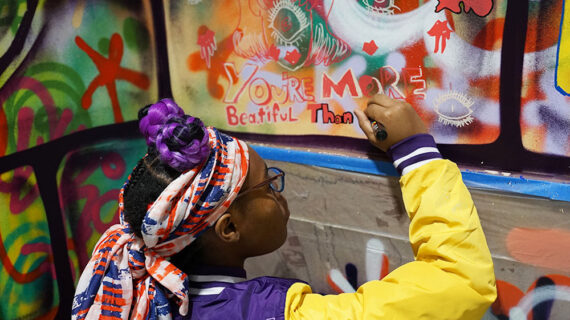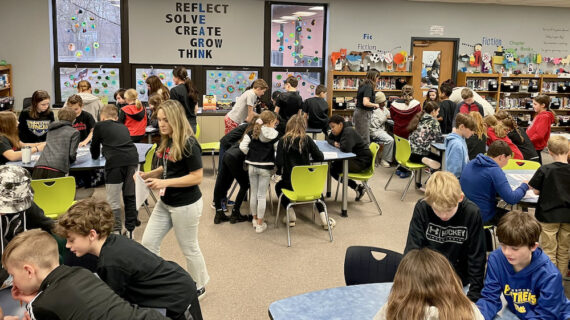
Restitching the bonds between students and teachers, Brownsville Area School District looks for a WIN
This story is one in a series created in collaboration with the AASA Learning 2025 Alliance to celebrate the work of groundbreaking school districts in the Pittsburgh region. Kidsburgh will share these stories throughout 2024.
Every child needs a village of caring adults looking out for them. How can schools give students this vital kind of support — and let them know they are so much more than simply names on an attendance sheet?
For Brownsville Area School District, that question has been front and center as they work to make the bonds between teachers and students as full and resonant as they can be.
The mantra: It’s about relationships.
“Kids need solid relationships with the adults teaching them and to know they have people in their corner,” says Superintendent Keith Hartbauer. “And when discipline problems arise, we know giving someone a suspension doesn’t work. We need to really ask: What’s the root of the problem? Why is this kid doing this?”
The first epiphany at Brownsville came right as the pandemic subsided. Teachers and administrators in the district, which straddles parts of Washington and Fayette counties southeast of Pittsburgh, realized that returning to the structure of full weeks in school wasn’t easy for many. Mental health issues had surfaced. Kids needed to learn to manage their emotions after feeling disconnected for so long.
Brownsville is part of the Western Pennsylvania Learning 2025 Alliance, a regional cohort of school districts working together — with support from The Grable Foundation — to create student-centered, equity-focused, future-driven schools. Hartbauer and his team have a chance to really connect with other districts through the Alliance, which is led by local superintendents and AASA, The School Superintendents Association. And they knew they weren’t alone in tackling these post-pandemic challenges.
But they needed a solution that was right for their community. So they asked: How do we make things better?
“Our kids felt that they weren’t really known by their teachers, even though teachers felt they did know their kids,” Hartbauer says. A districtwide survey backed that up. In it, 85 percent of students said their teachers didn’t really know who they were.
Whether truth or merely perception, the data had significant implications. Attendance was being impacted. The school environment was suffering. “We needed to do something that was more student-centered,” Hartbauer says.

ADDING A ‘WIN’ COLUMN
That something was “WIN” — the “What I Need” period, deployed for all students from kindergarten through high school. This free period, which takes place at least once a week, focuses specifically on students’ well-being and what they need and want. It has three goals:
To help students with their personal academic needs and offer extra support with something they’re struggling with (or extra exposure to something that really appeals to them).
To enable students to learn new skills in small groups with a teacher — anything from crocheting to archery to changing a tire.
To enable kids and teachers to connect as people, excited about the subjects they’re exploring and the skills they’re building.
An approach like this, administrators say, clears the way to address two of the most vexing issues schools nationwide are facing: attendance and discipline.
How do you make sure the kids show up? WIN entices them in a new way, appealing to their interests and needs to create the conditions for engagement and presence.
And when it comes to discipline, old-fashioned in-school suspension is being replaced by something called Restorative Support Services, which brings behavioral health experts and their skills into the equation. With this approach, students do their classwork but also take a virtual class dealing with what landed them there.
There’s incentive: If they really focus and get it all done in one day, they can avoid the second day of suspension. The future is in their hands.
Augmenting this is a newfound focus on mentorship. The district is training teachers to serve as mentors to small circles of kids, who gather and establish a comfort zone in which they can talk. Therapists from a local behavioral health outfit, Chestnut Ridge, have been incorporated into school days in many ways. Their presence, say leaders, has become necessary.
But it’s the WIN program that is paying the most obvious dividends for students, both operationally and in terms of mental health. It gives them agency and elbow room — two things young people often feel they’re lacking.
“A lot of the students that I see really like that extra piece of time for the academic help, just because they might be behind or they feel like they can use that and then not go home and have things to do at home, especially if they have a job after school or sports,” says Kellie Stout, principal at the high school.
Teachers, too, are more engaged because they’re able to convey their skills and passions to students in new ways. Says Assistant Superintendent Kristin Martin: “They’re excited to have those time periods with the kids. We allow the teachers to choose their area that they excel at and that they’re excited about.”
Unstructured time. New skills and passions. Mentorship. Getting to know your teachers and having them know you. A community with new bonds and new opportunities, emerging from a pandemic disruption whose echoes are still being felt years after lockdown ended.
These are evolutions — productive and challenging, full of potential, and beginning to take shape.
“It’s still a work in progress. The biggest obstacle that we had was that this is a change,” Hartbauer says. “Change isn’t easy. But we’re a lot further along than we were a year and a half ago.”
Want to download this story? Click here for a PDF.


















